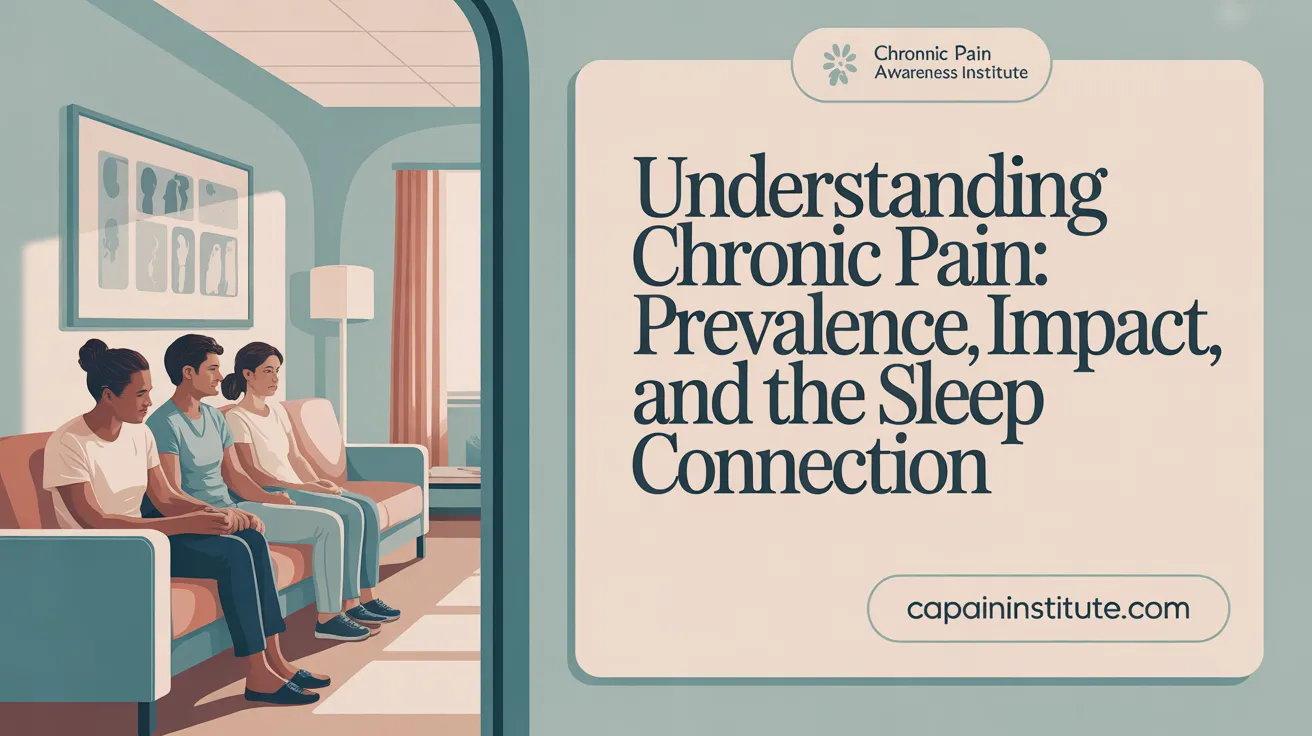Understanding the Interplay Between Sleep and Chronic Pain
Chronic pain affects millions worldwide, disrupting daily life and diminishing quality of life. Concurrently, sleep disturbances are rampant among those living with chronic pain, creating a complex and bidirectional relationship that challenges effective management. Exploring this relationship unveils how sleep quality profoundly influences pain perception and severity, and how improving sleep may offer a pivotal strategy in pain treatment. This article delves deep into the biological mechanisms, recent research, and practical approaches connecting sleep with chronic pain, providing essential insights for patients and healthcare providers alike.
<!-- VIDEO:eyJsaW5rIjoiaHR0cHM6Ly93d3cueW91dHViZS5jb20vd2F0Y2g/dj1tX1lnWVB4eDB3ayIsImltYWdlVXJsIjoiZGF0YTppbWFnZS9qcGVnO2Jhc2U2NCwvOWovNEFBUVNrWkpSZ0FCQVFBQUFRQUJBQUQvMndDRUFBa0dCd2dIQmdrSUJ3Z0tDZ2tMRFJZUERRd01EUnNVRlJBV0lCMGlJaUFkSHg4a0tEUXNKQ1l4Sng4ZkxUMHRNVFUzT2pvNkl5cy9SRDg0UXpRNU9qY0JDZ29LRFF3TkdnOFBHamNsSHlVM056YzNOemMzTnpjM056YzNOemMzTnpjM056YzNOemMzTnpjM056YzNOemMzTnpjM056YzNOemMzTnpjM056YzNOLy9BQUJFSUFGTUFsQU1CSWdBQ0VRRURFUUgveEFBYkFBQUNBZ01CQUFBQUFBQUFBQUFBQUFBQUFnRURCQVVHQi8vRUFEUVFBQUVFQVFNQ0JRTUNCUVFEQUFBQUFBRUFBZ01SQkFVU0lURkJCaE1pVVdFeWNZRVVrUlZDc2RIeEkzS2h3UWNXUS8vRUFCb0JBQU1CQVFFQkFBQUFBQUFBQUFBQUFBQUJBd0lFQlFiL3hBQWtFUUFDQWdFRUFnRUZBQUFBQUFBQUFBQUFBUUlSQXdRU0lURXlRVkVGSWtKeGtmL2FBQXdEQVFBQ0VRTVJBRDhBODVwQ2RkTnBHRmhhMkkyNGNUSWRRamFCSmpYNlp3MytkbDkrUFUzMkpjT2xMSjlsa21vSzMwY3NtcGJyTzBXWFRtU055YWhIbk9iNWszRk1hU0JYdTV4QjRIWWRnVnFKQTBPOUFlR2RpOFVTZ2NaeG4wVjBwcFNoQnVpS1VFSmtrbDF3Z1Q0UWppZVZXZUZMM1h6MzdvQXNXa2M3ZHNzYWVnNnBra1phRDFUM2RwbFk4b0ZDbWxPMUJxaFVJZHhTRzkwV0lFS2FRZ2RDcVZLRUNvc1hTNHZoN3pKTU9YQ3ovSWxjWTNBdWNBNk54Qk80OU50RnBxcnNjMnVhV3kvaTNvRGY0Zmg4Q2hUVC9kSVdXTTJ2dFoyck5TMXQ4RWpzdldZTW1jc2FZM1B4WW5PQkljNHQ1Rm5vQUJZNU5MVjZzY2wyQnFCeXN6VHNqWkNDREJoeE5PNGx2TzZycWlhSTZrSDJYUERWdHNoZWNIRmNTMnR0R3VsWFYvbFkyWHFwbWhmRU1MRWozajZtTU50NUo0cy9LRGplbmxCMmt2NGpHUXBnaG1mQStac1Vqb21HblNCaDJ0K0NleWxyWE8rbHBQSUhBN25vaXowRTAxWWlya05GV25yeXAvVFR6czNSUVN5TUJEUzVqQ1FIRTBCeDNQWkRNNU9FWTFCdzlrbzlsWnNMU1czVmRSN0twOUFsQkYvSXhhQWIzY0t5SWlqOTFVSTNiUTV3SUI1YWE2aFBDMno4RGxGamg1Y0Z5amxXc3g1WFJ2bFpCSStObjFQYXdrTis1N0tHeHVMRElHa3NCQUxxNEJOMEwvQi9ZcGJqb1NRZ2JmSlE0aHBIQ2lRMFFRb2U0TzRDUU5wY0V5SDBod1VkUmFnM1ZFOEtCd3RJeTNiR1FwUW1BNkVJU0tGYjNlb0QyS3JkMC9yYWFScEtSenpaRklPZWIrVGY2THEySmg2VEppVHNlNlJ6c2lnMWwySlltc29PM0RiOVBQcGR3dHM3eEhwN01sNzhYR0VNWG13U3RiSGlNQklqZTUydytvODA0QU9IdFZMaW1PZGZVL2haVVlNaDJSZ3VjQjlMUlpSUktPSEU3Y2pvOG5YdE1iQVBKdzQzemY2cDh4K0d5eklRL2EvNnE2dVpiU0Q5UHdGZzZIcStMaVk0Wm5lZkpzbkV6STQ0dzJuVzBrNzl3NElieTB0STRGVWVScUpXbG9JY0NDT3hGRlk1ZFI5d2ZkQXA0SUpWNloxamRmMFZyNEIrZ1lka1pHOTJHMXpteVVMZjlmcjNVNDBlbTd2WE5XcFpPajV1QkZqdytUREpKSDV3TVdNMENGdzgwN2R3ZHVKZDZHN1QwRkd6UVhLRTg4S1d1TGVSd2dpc01VKzJiL1R0VDAyQ1BUVG1NbWtmaVJTeG1Jd05leTNPZVd2K3NYdExnZHBIYnFzMlBYdElFc0x6ak1ZV3p2Y1JIZ00yN0hBKzd5ZDNTdXc3ZzBGeVJKUEpVeHRkSkl5TmpTNTdqVFdnV1NmaElieFJ1N04vQnJiY1BUNThmR2hQbXlaRWptUGtzYkkzTUxPeEEzVWU0STlsbVptdTZRNTdqaTRadHNlMWpuNHNZRmhtUUdsemJJTkdTRyt4OHM4Y0FMVTVHaDZ2RkZ2bDBuVUkyQVdYT3hYZ0FlL1Jhd1VrVWNJTjJtWm1yNU1PWHFFMlJqUitYSEpSMjdRMmp0RzdnY0RteXNLMUo1U0pvMTF3UHVzY25sQWNSM1NLVXg3bVpEWFcyeWhJMXhyb1VJS3FYQmVvZDlKVXFsN25YZkkrRUZaeXBDa2kvd0NiOEpTYmNhVUF1VWRyUWNyZGcyTitSUEhqd3l0WStSMUgzQzYzVDlDYm52Wmc0bTh2YWEyTjUrNVA5L2xjbm9MbWpYUlRUNXdzdHMvSDlsN0I0VWJqczB2RGxFVHhrL0RxQklOdVBQQlBKVTVNOExMT1dUSTdaelBpRHc0Tk04ckhubjgwU05JQkE1amVPYXYycitpNGpJak1Vem8zRDFNTkZlcCtMVzRzYmNJUXNJY1pYT2VYRytnSU5mdXZOOWVJL2ljclIyQXY3MG5CblZvc2t0emg2TmVUeWlyQlVKaFczbjNXejBSb29YelN4UlFndmtrY0dOYU9wY1RRQzliejlNYjRDMFhUY1BTblF0MXpVNVJGTnFEMmh6b20xNnRsOUFPQi93QTlWNTU0T2tpajhWYVJKS0JzYmxNSko2WGZIL05MdC9IK3A0MC9qWFFvczRrNGVPQzZTblZUbkdoejI2RDkwZW1lWjlRbTkwWWVpM0w4Q2Zwc2IrSWFYcTJVL1dZbmVmNXJwQVpIbXV4NjMvVllHb2FkamVNL0JzdmliRmdaajYxcDl0MUdPSnUxdVExdkpmWFk3ZlZmdzRjMEs3M1RjckZmajQrWDVQMFJ1YVhFOHhqNXYvSzREd0Q0cWgvOXQxaUtXTmtlQm00N21CalBwRFkyRWduN2dPSi8zTEVYWnlKdkZOU2llZnZBYlJIc3FrM094b0k3SkZwSDBFdXdVcUZDWmthL2xTbFFuUTdNeDFkTFZKYTRja2doUnYzRWJoWTk2UVEzYngxKzZ5WGxKU0RhMGpnMHAyVTBBRWRleFVQSFN1T0Z0NDV0Q2MxcGRoNWdjQnlHeWluY0g1RmMxK3lSS1QydnF6RjBBWXVQcXNXUm1zSTIvUyt1QWVuUHhTNy9BTUQ1a3pZSm1Bc2tqam5jNE5MdUtKdXdWeEdTL1JwSUhuRnhjaGsrMEJwTC9SZFZkV1Q4cTR5YUEvSkJkajVjREhQTnRhL2NBTzNlL245L3dtclp4WmRJcHZlazBianhacXNVK281SmtjSGlOdmxReE1QRFIxSi9mK2k0dVF1a2tjK1J4TDNHeVN0MUkvUlJISTJMSHpOK3owMjlvcHllTi9oK1Y4UW54c21KaGR5NFBzRGptNnNteVB4ZjVUWEJYSHA0NFk4SnRuUFVib2NwMnQ5QitUVnJjWXN1andqeTU4V1djQzkwelNXaytvRWVtK2xDbGdTK1ZLOXh4bWxrZTcwZy93Q1QrMW43bnFuWmFDYmxWR1BFQ0NDMXpnN3FDT3hXUnJHVmxhalBKazVuK3E5N1FIR3V2NFdWZ0hEWTkvNjZON21GbER5eDZnNnh6MUhhMWtPazBFeUFESHptanNkNEo2L2RLekdwMDBNa2Rzay8yanM4Zkp6OEgveGVjckluTXNwZ0xJeVRlMXJxQVB5UUN2Tk1LU1NCc2dpTzB2YTVoSTZrSGdqOGpqOGxibzVHaW1hVzhYS01idHZsQVBGczY3dTljOEVleVdKK2t3NVhtakVsa2hMYThsenlDMDdoNnJ2bjAzeDdwSlVReGFGS2FrMDNScG5BM3lxbHRkVmZoUEVQNkNHU01DdzdlYko2VjNQenp4MUhzdFkwRWtqdGEwanNhSURTVkJGSzBEZ2ZsSzVnQU5EdW1KeDRLa0p3MGtkRktMTVVXVjZCOTBnNmxRaEl0TDBQSjFiK0ZaR1BUSDlpaENYbzFIeUNQNlhJZjlRUWhCVDhVV08rcDMyUUFPT095RUpGVUk4VXgvM1NSY1JDdmNvUW1TZmtXSC9vSlA4QTZ0UWhBbUJSQVNYR3loQ0FYa05OL0w5MVF6cTc3b1Ftak9UekhIUlNVSVFKZENrQkNFSmt6Ly9aIiwidGl0bGUiOiJCZXR0ZXIgU2xlZXAsIExlc3MgUGFpbiIsInNuaXBwZXQiOiJTbGVlcCBhbmQgcGFpbiBhcmUgY2xvc2VseSBjb25uZWN0ZWQg4oCTIHBvb3Igc2xlZXAgY2FuIG1ha2UgcGFpbiB3b3JzZSwgYW5kIHBhaW4gY2FuIGFsc28gbWFrZSBpdCBoYXJkZXIgdG8gZ2V0IHF1YWxpdHkgc2xlZXAuIn0= -->The Bidirectional Relationship Between Sleep Quality and Chronic Pain

What is the relationship between sleep quality and chronic pain?
Chronic pain and poor sleep are deeply interconnected, influencing each other in a complex, bidirectional manner. When sleep is disrupted or insufficient, it can heighten pain sensitivity, lower pain thresholds, and increase the likelihood of hyperalgesia—which is an increased response to painful stimuli.
Conversely, experiencing chronic pain often interferes with sleep patterns, causing difficulties such as trouble falling asleep, frequent awakenings, and reduced restorative sleep stages. This disruption in sleep can then intensify pain perception and severity, creating a cycle that can be challenging to break.
Research consistently shows that sleep disturbances are very common among individuals with chronic pain conditions—up to 88% experience some form of sleep difficulty. This cycle not only worsens the pain itself but also impacts overall health, contributing to fatigue, mood disturbances, and decreased quality of life.
Underlying neurobiological pathways are involved in this relationship. Systems such as the opioid, serotonin, and inflammatory pathways are affected by sleep deficiency, which can further diminish the body's natural pain control mechanisms. When sleep is poor, inflammatory responses are heightened, and neurotransmitters involved in pain regulation, like serotonin and norepinephrine, become dysregulated.
Efforts to improve sleep can lead to better pain management outcomes. Therapies such as cognitive-behavioral therapy for insomnia (CBT-I), physical activity, and relaxation techniques have shown promise. Addressing sleep quality is thus an important part of a comprehensive approach to managing chronic pain.
In summary, the connection between sleep and pain is both significant and bidirectional, emphasizing the need for treatments that target both problems simultaneously to enhance patient health and wellbeing.
Why Understanding Sleep’s Role Is Vital in Pain Management and Overall Health
Why is understanding the role of sleep important in pain management and overall health?
Recognizing how sleep influences health is crucial because restful, quality sleep supports the body's physical recovery, immune system, and mental well-being. Studies indicate that a significant portion of individuals with chronic pain—ranging from 67% to 88%—experience sleep disruptions such as trouble falling asleep, waking frequently, or feeling unrefreshed in the morning.
Sleep and pain are closely connected in a cycle. Poor sleep can heighten pain sensitivity by affecting neurochemical systems, including serotonin, norepinephrine, and inflammatory pathways. For example, sleep deprivation elevates systemic inflammation and activates hyperalgesic pathways, leading to increased pain perception. Conversely, pain itself can disturb sleep patterns by causing difficulty in falling asleep or frequent interruptions, which in turn worsens pain and overall health.
This bidirectional relationship underscores that addressing sleep issues is essential in pain management. Effective interventions like cognitive behavioral therapy for insomnia (CBT-I), sleep hygiene education, and relaxation techniques can significantly improve sleep quality. Better sleep helps lower inflammation, increase pain thresholds, and improve mood, thereby making pain more manageable and potentially reducing the reliance on medications.
Moreover, good sleep supports immune function, aids physical recovery, and enhances mental health—factors vital for those managing chronic conditions such as arthritis, fibromyalgia, and migraines. Overall, comprehensive treatment of sleep disturbances not only alleviates pain but also promotes long-term health, longevity, and improved quality of life.
Research highlights the importance of viewing sleep as a fundamental component of pain management. Addressing sleep quality through multidisciplinary strategies offers a promising pathway to reduce pain severity, prevent associated health risks, and sustain overall wellness.
Impact of Sleep Disturbances on Chronic Pain Conditions

How do sleep disturbances impact chronic pain conditions?
Sleep problems are extremely common among individuals with chronic pain, with estimates indicating that between 67% and 88% of these patients suffer from issues such as insomnia, sleep fragmentation, or inadequate rest. These disturbances not only make pain feel worse but also contribute to the worsening of symptoms.
One of the main ways sleep disruptions affect chronic pain is by increasing pain sensitivity. When sleep quality declines, people often experience a lower pain threshold and heightened pain perception, leading to more intense pain experiences. This creates a cycle where pain interferes with sleep, and poor sleep amplifies the pain.
Furthermore, poor sleep impacts several neurochemical systems involved in pain moderation. It dysregulates neurotransmitters like serotonin, dopamine, and norepinephrine, which play roles in both sleep regulation and pain perception. Additionally, disrupted sleep activates inflammatory pathways, increasing cytokines like IL-6 and prostaglandins, which contribute to systemic inflammation and pain.
Conditions such as insomnia and sleep apnea can intensify the severity of pain symptoms, affecting daily functioning and quality of life. Notably, sleep disturbances can also predict future pain episodes, including headaches, migraines, and postoperative pain.
Research suggests that interventions aimed at improving sleep—such as cognitive behavioral therapy for insomnia (CBT-I), physical activity, and mindfulness—can effectively reduce pain severity. Recognizing and addressing sleep issues as part of chronic pain treatment plans is therefore essential for better management and improved patient outcomes.
Examples of chronic pain conditions affected by sleep issues
| Condition | Prevalence of Sleep Problems | Specific Sleep Issues | Impact on Pain and Daily Life | Additional Notes |
|---|---|---|---|---|
| Rheumatoid Arthritis | Up to 65% | Difficulty falling asleep, waking early | Increased joint pain, morning stiffness | Sleep issues can predict flare-ups |
| Osteoarthritis | 70% | Sleep fragmentation, insomnia | Worsened joint pain, reduced mobility | Sleep quality correlates with pain severity |
| Fibromyalgia | 95% | Widespread sleep difficulties | Exacerbation of widespread pain | Sleep intervention improves symptoms |
| Migraines/Headaches | Strongly linked to poor sleep quality | Trouble falling asleep, frequent awakenings | Increased attack frequency and intensity | Sleep quality measures are strongly correlated |
Effective treatment of sleep disorders related to these conditions can lead to significant pain reduction and improved quality of life. Employing behavioral strategies alongside medical interventions can help manage this complex relationship and ease symptom burden.
How Poor Sleep Exacerbates Pain Severity and Challenges Pain Management
How does poor sleep affect the severity and management of pain?
Poor sleep dramatically influences the severity and persistence of pain. When sleep quality diminishes—whether through insomnia, fragmented sleep, or feeling unrefreshed—pain sensitivity increases, making individuals more prone to experiencing pain more intensely. Conversely, pain itself can interfere with sleep, creating a vicious cycle that is challenging to break.
Research indicates that disrupted sleep lowers the body's pain thresholds, meaning that stimuli which might not normally be painful can become painful experiences for individuals with poor sleep quality. This heightened pain perception not only worsens everyday discomfort but also hampers effective pain management strategies.
At the neurobiological level, sleep deprivation elevates levels of inflammatory cytokines, such as IL-6 and prostaglandins, and dysregulates neurotransmitters like serotonin, dopamine, and norepinephrine. These biochemical changes amplify pain signals and impair the body's ability to inhibit pain naturally, further intensifying the pain experience.
The relationship between sleep and pain shares a two-way link. While pain can disrupt sleep architecture, lack of restorative sleep also worsens the body's capacity to regulate pain, contributing to chronic pain development and progression.
Fortunately, interventions like cognitive behavioral therapy for insomnia (CBT-I), relaxation techniques, and good sleep hygiene practices have demonstrated significant benefits. By addressing sleep disturbances, these strategies enhance sleep quality, which can reduce pain severity and improve the effectiveness of pain management.
In summary, improving sleep quality is vital in the comprehensive treatment of chronic pain. Adequate and restful sleep can lower pain sensitivity, strengthen the body's natural pain inhibitory systems, and support overall health and well-being.
Biological Mechanisms Connecting Sleep Quality and Pain Perception
What are the biological mechanisms that link sleep quality and pain perception?
The connection between sleep quality and pain perception involves a complex interplay of neurobiological systems that regulate both sleep and pain. When sleep is disrupted or insufficient, numerous pathways in the body are affected, leading to heightened pain sensitivity.
One major factor is the dysregulation of neurotransmitters such as serotonin, dopamine, and norepinephrine. These chemicals are vital in modulating pain signals and maintaining mood stability. Sleep deprivation impairs their balance, which can diminish the effectiveness of pain inhibition pathways.
In addition, the endogenous opioid system, which normally helps suppress pain, becomes less effective with poor sleep. Studies show that sleep loss reduces activity at μ-opioid receptors and hampers the body’s natural pain-relief mechanisms. This impairment can result in increased pain perception.
Sleep deprivation also triggers immune responses, elevating inflammatory cytokines like IL-6 and TNF-alpha. These molecules promote inflammation and sensitize pain pathways, which leads to hyperalgesia—an increased sensitivity to pain.
Furthermore, the hypothalamic-pituitary-adrenal (HPA) axis, responsible for stress hormone regulation, becomes dysregulated with poor sleep. Elevated cortisol levels associated with HPA axis activation can intensify pain signals, creating a cycle of pain escalation.
Other neurochemical systems involved include orexin, melatonin, adenosine, nitric oxide, and the endocannabinoid system. For example, decreased melatonin, which helps regulate circadian rhythms and has analgesic properties, can amplify pain perception. Increased adenosine signaling and nitric oxide production during sleep deprivation also sensitize pain pathways.
In summary, disrupted sleep impacts multiple neurochemical and immune pathways, fostering an environment where pain perception is heightened. These alterations contribute to the maintenance and worsening of chronic pain conditions, forming a vicious cycle that is challenging to break.
Understanding these mechanisms highlights the importance of good sleep hygiene and potential therapeutic targets for managing chronic pain, including interventions aimed at restoring normal neurochemical balance.
Chronic Pain and Its Global Impact on Health and Functionality

Prevalence and common chronic pain conditions
Chronic pain is a widespread issue, affecting approximately 50 million adults in the United States alone. It encompasses a variety of conditions such as arthritis—including osteoarthritis—back pain, migraines, fibromyalgia, and neuropathic pains. These conditions often persist for more than three months and can severely challenge an individual's daily life.
Effects on mobility, daily activities, and fatigue
Individuals living with chronic pain frequently experience decreased mobility, making everyday activities more difficult. Pain may cause fatigue and exhaustion, further reducing their ability to work, socialize, and participate in hobbies. This decrease in functional capacity can lead to a cycle of inactivity and worsening health.
Mental health consequences including depression and social isolation
Chronic pain is closely linked to mental health challenges such as depression and anxiety. The persistent discomfort often leads to social isolation as individuals withdraw from social interactions to avoid pain triggers. This isolation, combined with ongoing pain, can diminish overall well-being and quality of life.
The interplay of chronic pain with sleep disturbances
Sleep problems are highly prevalent among those with chronic pain, with studies indicating that up to 88% experience sleep difficulties. Conditions like trouble falling asleep, frequent nighttime awakenings, and early waking are common. Poor sleep not only worsens pain perception but also impairs mood, cognition, and immune function.
The relationship between sleep and pain is bidirectional; pain disrupts sleep, and insufficient rest increases pain sensitivity. Neurobiological pathways involving neurotransmitters like serotonin and norepinephrine, as well as inflammatory processes, mediate this connection. Interventions such as cognitive behavioral therapy for insomnia (CBT-i) and good sleep hygiene practices have shown promise in mitigating this cycle.
| Aspect | Impact | Additional Details |
|---|---|---|
| Chronic pain conditions | Osteoarthritis, fibromyalgia, migraines | Affect daily activities and increase fatigue |
| Sleep disturbances | Sleep difficulty, insomnia | Up to 88% experience sleep issues |
| Mental health | Depression, social isolation | Exacerbated by pain and sleep problems |
| Functional limitations | Reduced mobility, activity restriction | Leads to decreased quality of life |
| Neurobiological factors | Neurotransmitter dysregulation, inflammation | Underlying mechanisms linking pain and sleep |
Recent Advances and Research Highlights in Sleep and Chronic Pain

What recent research findings shed light on the connection between sleep and chronic pain?
Recent studies have significantly advanced our understanding of how sleep and chronic pain influence each other. It is now clear that there is a strong bidirectional relationship: poor sleep quality can heighten pain sensitivity, while persistent pain can further disrupt sleep patterns.
Research consistently reports a high prevalence of sleep disturbances—such as insomnia, sleep apnea, and restless legs syndrome—among individuals with chronic pain conditions. In some populations, up to 88% of those suffering from chronic pain experience sleep issues, highlighting how common and impactful this problem is.
Technological innovations are powering new insights into this complex relationship. Wearable devices capable of polysomnography and sleep tracking, combined with machine learning algorithms, allow researchers to analyze detailed sleep data at large scale. These tools help identify individual patterns and mediators like depression, anxiety, and systemic inflammation that influence both sleep and pain.
One key finding involves the role of neurochemical mediators. Sleep disturbances alter neurotransmitters such as serotonin and norepinephrine—both involved in pain perception and regulation—while also affecting inflammatory pathways. For example, sleep loss increases cytokines like IL-6 and prostaglandins, which can enhance pain sensitivity.
In terms of treatment, evidence supports the effectiveness of behavioral and psychological interventions. Cognitive Behavioral Therapy for Insomnia (CBT-I) has shown promising results in improving sleep quality and reducing pain levels. Additionally, mindfulness-based programs and digital health interventions centered on relaxation techniques are emerging as effective non-pharmacological options.
These research advances emphasize the importance of comprehensive, personalized treatment strategies. Addressing sleep disturbances in chronic pain patients not only alleviates sleep-related issues but can significantly improve pain management outcomes, decreasing reliance on medications and enhancing quality of life.
| Key Points | Findings | Implications | Additional Notes |
|---|---|---|---|
| High prevalence of sleep issues | Up to 88% of chronic pain sufferers have sleep problems | Need for routine sleep assessment in pain clinics | Sleep disturbances often go unrecognized and untreated |
| Neurochemical mediators | Changes in serotonin, norepinephrine, cytokines | Targeting these mediators may offer new treatment pathways | Advances in understanding neurobiology pave the way for novel therapies |
| Technological tools | Wearables, machine learning for sleep analysis | Enable personalized assessments and interventions | Potential for large-scale research and tailored therapies |
| Effectiveness of behavioral treatments | CBT-I, mindfulness programs improve sleep and reduce pain | Incorporate into standard pain management protocols | Emphasizes non-drug approaches for sustainable benefits |
Research continues to build on these findings, supporting integrated management strategies that consider sleep health as a vital component of chronic pain treatment. As science uncovers more about the biological and psychological underpinnings, personalized, targeted therapies are becoming increasingly feasible and effective.
Strategies to Improve Sleep Quality for Effective Chronic Pain Management

What strategies can be employed to improve sleep quality for managing chronic pain?
Improving sleep in individuals with chronic pain requires a comprehensive, multi-pronged approach. One of the most effective methods is cognitive-behavioral therapy for insomnia (CBT-I). This structured therapy helps identify and change negative thoughts and behaviors that disrupt sleep, leading to better sleep patterns.
Good sleep hygiene practices are also essential. These include maintaining a consistent sleep schedule, going to bed and waking up at the same times every day, even on weekends. Creating a sleep-friendly environment with a comfortable mattress and pillows, keeping the room cool, dark, and quiet reduces disturbances. Avoiding complex activities or stressful discussions before bed can help promote relaxation.
Relaxation and mindfulness techniques serve as valuable tools to ease the mind and muscles before sleep. Practices such as deep breathing exercises, progressive muscle relaxation, meditation, or taking a warm bath can lower stress levels and reduce physical tension, making it easier to fall asleep.
Physical activity is beneficial for both sleep and pain reduction, but should be timed carefully. Engaging in gentle exercise like walking or stretching earlier in the day can promote restorative sleep. However, vigorous activity close to bedtime might interfere with sleep onset, so scheduling workouts earlier can be more effective.
When necessary, Pharmacological support can be considered under medical guidance. Proper medication timing can help manage pain that disrupts sleep. Still, reliance on medications should be cautiously balanced to avoid dependency and side effects.
Additionally, limiting caffeine intake in the afternoon and evening, reducing screen exposure before bed to prevent blue light interference with melatonin production, and managing pain through appropriate medication use all contribute to better sleep.
Seeking support from sleep specialists or healthcare providers ensures personalized strategies, especially for those with persistent sleep issues related to chronic pain. Combining these tactics creates a synergistic effect in reducing pain and improving sleep quality, ultimately enhancing overall well-being and daily functioning.
Objective and Subjective Assessment Tools for Sleep Quality in Chronic Pain
Polysomnography and actigraphy for objective sleep measurement
To accurately evaluate sleep quality in individuals with chronic pain, clinicians often use tools like polysomnography and actigraphy. Polysomnography is a comprehensive overnight sleep study that records brain activity, eye movements, muscle activity, heart rate, and breathing patterns. It provides detailed information about sleep stages, disturbances, and fragmentation. Actigraphy involves wearing a wrist device that tracks movement to estimate sleep patterns over extended periods. This type of monitoring is less intrusive and can be used in natural sleep environments, offering valuable insights into sleep duration and continuity.
Questionnaires like PSQI, ISI, and sleep diaries for subjective assessment
Alongside objective measures, subjective assessments are essential for understanding sleep issues. The Pittsburgh Sleep Quality Index (PSQI) evaluates overall sleep quality over the past month, including sleep latency, duration, and disturbances. The Insomnia Severity Index (ISI) focuses specifically on insomnia severity and its impact on daily functioning. Sleep diaries are daily logs kept by patients that record bedtimes, wake times, perceived sleep quality, and nocturnal awakenings. These tools help capture personal experiences and identify patterns that might not be evident in polysomnography or actigraphy.
Importance of comprehensive evaluation for treatment planning
A thorough assessment combining both objective and subjective tools enables healthcare providers to tailor effective interventions. Understanding individual sleep patterns, perceptions, and underlying disturbances guides treatment strategies, such as cognitive behavioral therapy for insomnia (CBT-I), lifestyle modifications, or medication adjustments. Proper evaluation is crucial for breaking the cycle of sleep disturbance and pain, ultimately improving both sleep and pain outcomes in chronic pain management.
The Role of Neurochemical Changes in Sleep Loss and Pain Perception
Effects of sleep deprivation on N-arachidonoyl dopamine (NADA) and cannabinoid receptors
Sleep loss has significant effects on neurochemical systems involved in pain regulation. One important molecule affected by sleep deprivation is N-arachidonoyl dopamine (NADA), a neurotransmitter that targets cannabinoid receptors. NADA plays a role in modulating pain perception, acting as an internal pain control mechanism.
Studies have shown that sleep deprivation reduces levels of NADA in the brain. This decrease can impair the natural pain-inhibiting pathways, leading to increased pain sensitivity.
Consequences of reduced NADA on pain sensitivity
Lower NADA levels due to sleep deprivation mean that the body's ability to suppress pain diminishes. This can lead to hyperalgesia, an increased sensitivity to painful stimuli, even without any actual increase in noxious stimulation.
Research using mouse models indicates that boosting NADA levels might counteract this heightened pain perception. In experiments, increasing NADA in sleep-deprived systems helped negate the increased pain response.
Potential therapeutic implications for non-narcotic pain treatments
These findings open a promising avenue for developing non-narcotic, neurochemical-based therapies for chronic pain, especially in those experiencing sleep disturbances. By targeting the endocannabinoid system and restoring NADA levels, new treatments could be created that manage pain without the risks associated with opioids.
Ongoing research aims to isolate active components from cannabis that effectively target this pathway, potentially leading to innovative, less addictive pain management options. Improving sleep quality by addressing neurochemical imbalances might significantly reduce pain perception and improve overall health.
Breaking the Pain-Sleep Cycle: Behavioral and Lifestyle Recommendations
Benefits of establishing consistent sleep routines
Setting a regular sleep schedule helps regulate the body's internal clock, aiding in better sleep quality. Going to bed and waking up at the same times every day minimizes disruptions to sleep patterns, which is especially beneficial for individuals dealing with chronic pain. Consistency in sleep timing can reduce pain sensitivity and improve overall well-being.
Creating a conducive sleep environment
A sleep-friendly environment is crucial for restful sleep. This includes maintaining a cool, dark, and quiet bedroom, using comfortable bedding, and limiting distractions like electronic devices. Reducing screen time before bed diminishes blue light exposure, which can interfere with melatonin production and disrupt sleep cycles.
Mind-body techniques like CBT-I and relaxation
Cognitive Behavioral Therapy for Insomnia (CBT-I) is a highly effective, science-backed method for improving sleep quality. It helps change negative thoughts and behaviors related to sleep. Relaxation techniques such as deep breathing, progressive muscle relaxation, and mindfulness meditation can also decrease anxiety and facilitate quicker sleep onset, reducing pain-related sleep disturbances.
Appropriate timing of physical activity and pain management
Engaging in moderate physical activity during the day can promote better sleep. However, exercise should be scheduled at least a few hours before bedtime to avoid stimulating arousal close to sleep time. Properly managing pain through medication, physical therapy, or heat/cold therapy can decrease discomfort and improve sleep quality.
Importance of addressing psychological factors
Psychological factors such as anxiety, depression, and catastrophizing significantly impact both pain and sleep quality. Addressing these through counseling, relaxation techniques, and mindfulness can break the cycle of pain and poor sleep. Managing stress levels and emotional health is vital for sustaining long-term improvements.
Implementing these behavioral strategies collectively can help sufferers of chronic pain improve sleep, thereby reducing pain severity and enhancing overall quality of life.
Embracing Sleep Quality as a Cornerstone of Chronic Pain Management
The intricate and bidirectional relationship between sleep quality and chronic pain represents both a challenge and an opportunity in healthcare. Poor sleep exacerbates pain sensitivity and severity through multifaceted biological and psychological pathways, while chronic pain itself disrupts restorative sleep, perpetuating a vicious cycle. Emerging research underscores the critical importance of integrated, personalized, and non-pharmacological approaches—such as cognitive behavioral therapy for insomnia and sleep hygiene optimization—to improve sleep, reduce pain, and enhance quality of life for millions. Recognizing and treating sleep issues must become a fundamental part of chronic pain management strategies, ultimately fostering better outcomes, improved mental health, and overall wellbeing.
References
- The Importance of Sleep for People With Chronic Pain
- Commentary Chronic pain management and sleep disorders
- Sleep deficiency and chronic pain: potential underlying ...
- Researchers find link between poor sleep and chronic pain
- Managing Chronic Pain and Sleep
- Pain and Sleep: Common Sleep Disturbances & Tips
- Researchers Find Sleep Quality Can Impact Chronic Pain ...
